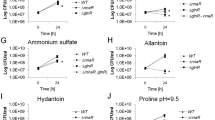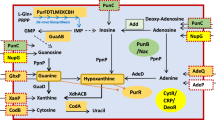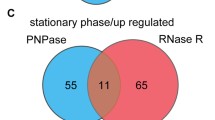Abstract
A mutation in the second gene in the ntrPR operon results in increased expression of nodulation ( nod) and nitrogen fixation ( nif) genes in Sinorhizobium meliloti. Since this pleiotropic effect is particularly pronounced in the presence of external combined nitrogen, a nitrogen regulatory function has been suggested for NtrR. To identify the complete set of protein-coding genes influenced by loss of ntrR function, microarray hybridizations were carried out to compare transcript levels in the wild type and mutant strains grown under aerobic and microaerobic conditions. Of the 6207 genes examined, representing the entire genome of S. meliloti, 7% exhibited altered expression: 4.5% of the genes are affected under oxic, 2.5% under microoxic conditions. 0.4% of all the genes are affected under both oxygen concentrations. A microoxic environment is required for the induction of genes related to symbiotic functions but results in the down-regulation of other (e.g. metabolic) functions. When the alterations in transcription levels at low oxygen concentration in the mutant strain were compared to those of the wild type, a modulating effect of the ntrR mutation was observed. For example, symbiotic nif/fix genes were induced in both strains, but the level of induction was higher in the ntrR mutant. In contrast, genes related to transcription/translation functions were down-regulated in both strains, and the effect was greater in the wild-type strain than in the ntrR mutant. A relatively wide range of functions was affected by this modulating influence, suggesting that ntrR is not a nitrogen regulatory gene. Since genes encoding various unrelated functions were affected, we propose that NtrR may either interfere with general regulatory mechanisms, such as phosphorylation/dephosphorylation, or may influence RNA stability.


Similar content being viewed by others
References
Ampe F, Kiss E, Sabourdy F, Batut J (2003) Transcriptome analysis of Sinorhizobium meliloti during symbiosis. Genome Biol 4:R15
Bagyan I, Hobot J, Cutting S (1996) A compartmentalized regulator of developmental gene expression in Bacillus subtilis. J Bacteriol 178:4500–4507
Bahar M, De Majnik J, Wexler M, Fry J, Poole PS, Murphy PJ (1998) A model for the catabolism of rhizopine in Rhizobium leguminosarum involves a ferredoxin oxygenase complex and the inositol degradative pathway. Mol Plant-Microbe Interact 11:1057–1068
Bardin S, Dan S, Osteras M, Finan TM (1996) A phosphate transport system is required for symbiotic nitrogen fixation by Rhizobium meliloti. J Bacteriol 178:4540–4547
Barnett MJ, et al (2001) Nucleotide sequence and predicted functions of the entire Sinorhizobium meliloti pSymA megaplasmid. Proc Natl Acad Sci USA 98:9883–9888
Becker A, et al (2003) Global changes in gene expression in Sinorhizobium meliloti 1021 under microoxic and symbiotic conditions. Mol Plant-Microbe Interact 17:292–203
Bergès H, Lauber E, Liebe, C, Batut J, Kahn D, de Bruijn FJ, Ampe F (2003) Development of Sinorhizobium meliloti pilot macroarrays for transcriptome analysis. Appl Environ Microbiol 69:1214–1219
Bhagwat AA, Tully RE, Keister DL (1992) Isolation and characterization of an ndvB locus from Rhizobium fredii. Mol Microbiol 6:2159–2165
Breedveld MW, Yoo JS, Reinhold VN, Miller KJ (1994) Synthesis of glycerophosphorylated cyclic β-(1,2)-glucans by Rhizobium meliloti ndv mutants. J Bacteriol 176:1047–1051
Capela D, et al (2001) Analysis of the chromosome sequence of the legume symbiont Sinorhizobium meliloti strain 1021. Proc Natl Acad Sci USA 98:9877–9882
Chen H, Teplitski M, Robinson JB, Rolfe BG, Bauer WD (2003) Proteomic analysis of wild-type Sinorhizobium meliloti responses to N -acyl homoserine lactone quorum-sensing signals and the transition to stationary phase. J Bacteriol 185:5029–5036
Choi EY, Ahn GS, Jeon KW (1991) Elevated levels of stress proteins associated with bacterial symbiosis in Amoeba proteus and soybean root nodule cells. Biosystems 25:205–212
Claverys JP (2001) A new family of high affinity ABC manganese and zinc permeases. Res Microbiol 152:231–243
Clissold PM, Ponting CP (2000) PIN domains in nonsense-mediated mRNA decay and RNAi. Current Biology 10:R888–890
Cook SA, Matsui T, Li L, Rosenzweig A (2002) Transcriptional effects of chronic Akt activation in the heart. J Biol Chem 277:22528–22533
Davey ME, de Bruijn FJ (2000) A homologue of the tryptophan-rich sensory protein TspO and FixL regulate a novel nutrient deprivation-induced Sinorhizobium meliloti locus. Appl Environ Microbiol 66:5353–5359
De Risi JL, Iyer VR, Brown PO (1997) Exploring the metabolic and genetic control of gene expression on a genomic scale. Science 278:680–686
Dessaux Y, Petit A, Farraud SK, Murphy PJ (1998) Opines and opine-like molecules involved in plant- Rhizobiaceae interactions. In: Spaink HP, Kondorosi A, Hooykaas PJJ (eds) The Rhizobiaceae. Molecular biology of model plant-associated bacteria. Kluwer Academic Publishers, Dordrecht, pp 181–197
Djordjevic MA, Chen HC, Natera S, Van Noorden G, Menzel C, Taylor S, Renard C, Geiger O, The Sinorhizobium meliloti Sequencing Consortium, Weiller GF (2003) A global analysis of protein expression profiles in Sinorhizobium meliloti: discovery of new genes for nodule occupancy and stress adaptation. Mol Plant-Microbe Interact 16:508–524
Dondrup M, Goesmann A, Bartels D, Krause L, Linke B, Rupp O, Sczyrba A, Pühler A, Meyer F (2003) EMMA: a platform for consistent storage and efficient analysis of microarray data. J Biotechnol 106:135–146
Dudoit S, Yang YH, Callow MJ, Speed TP (2002) Statistical methods for identifying differentially expressed genes in replicated cDNA microarray experiments. Statistica Sinica 12:111–139
Dusha I, Bakos A, Kondorosi A, de Bruijn FJ, Schell J (1989) The Rhizobium meliloti early nodulation genes ( nodABC) are nitrogen-regulated: isolation of a mutant strain with efficient nodulation capacity on alfalfa in the presence of ammonium. Mol Gen Genet 219:89–96
Finan TM, McWhinnie E, Driscoll B, Watson RJ (1991) Complex symbiotic phenotypes result from gluconeogenic mutations in Rhizobium meliloti. Mol Plant-Microbe Interact 4:386–392
Finan TM, Weidner S, Wong K, Buhrmester J, Chain P, Vorholter FJ, Hernandez-Lucas I, Becker A, Cowie A, Gouzy J, Golding B, Pühler A (2001) The complete sequence of the 1,683-kb pSymB megaplasmid from the N2-fixing endosymbiont Sinorhizobium meliloti. Proc Natl. Acad Sci 98:9889–9894
Fischer HM, Babst M, Kaspar T, Acuna G, Arigoni F, Hennecke H (1993) One member of a groESL -like chaperonin multigene family in Bradyrhizobium japonicum is co-regulated with symbiotic nitrogen fixation genes. EMBO J 12:2901–2912
Fischer HM, Velasco L, Delgado MJ, Bedmar EJ, Scharen S, Zingg D, Göttfert M, Hennecke H (2001) One of the two hemN genes in Bradyrhizobium japonicum is functional during anaerobic growth and in symbiosis. J Bacteriol 183:1300–1311
Fleischmann RD, Adams MD, White O, Clayton RA, Kirkness EF, Kerlavage AR, Bult CJ, Tomb JF, Dougherty BA, Merrick JM, McKenney K, Sutton G, Fitzhugh W, Fields C (1995) Whole-genome random sequencing and assembly of Haemophilus influenzae Rd. Science 269:496–512
Fry J, Wood M, Poole PS (2001) Investigation of myo -inositol catabolism in Rhizobium leguminosarum biovar viciae and its effect on nodulation competitiveness. Mol Plant-Microbe Interact 14:1016–1025
Galbraith MP, Feng SF, Borneman J, Triplett EW, de Bruijn FJ, Rossbach S (1998) A functional myo -inositol catabolism pathway is essential for rhizopine utilization by Sinorhizobium meliloti. Microbiology 144:2915–2924
Galibert F, et al (2001) The composite genome of the legume symbiont Sinorhizobium meliloti. Science 293 668–672
Holloway P, McCormick W, Watson RJ, Chan Y-K (1996) Identification and analysis of the dissimilatory nitrous oxide reduction genes, nosRZDFY , of Rhizobium meliloti. J Bacteriol 178:1505–1514
Hopper S, Wilbur JS, Vasquez BL, Larson J, Clary S, Mehr IJ, Seifert HS, So M (2000) Isolation of Neisseria gonorrhoeae mutants that show enhanced trafficking across polarized T84 epithelial monolayers. Infect Immun 68:896–905
Jiménez-Zurdo JI, Vandillewijn P, Soto MJ, Defelipe MR, Olivares J, Toro N (1995) Characterization of a Rhizobium meliloti proline dehydrogenase mutant altered in nodulation efficiency and competitiveness on alfalfa roots. Mol Plant-Microbe Interact 8:492–498
Kaneko T, Tanaka A, Sato S, Kotani H, Sazuka T, Miyajima N, Sugiura H, Tabata S (1995) Sequence analysis of the genome of the unicellular cyanobacterium Synechocystis sp. strain PCC6803. I: Sequence features in the 1 Mb region from map positions 64% to 92% of the genome. DNA Res 2:153–166
Katz ME, Strugnell RA, Rood JI (1992) Molecular characterization of a genomic region associated with virulence in Dichelobacter nodosus. Infect Immun 60:4586–4592
Kondorosi E, Bánfalvi Z, Kondorosi A (1984) Physical and genetic analysis of a symbiotic region of Rhizobium meliloti: identification of nodulation genes. Mol Gen Genet 193:445–452
Makarova KS, Aravind L, Galperin MY, Grishin NV, Tatusov RL, Wolf YI, Koonin EV (1999) Comparative genomics of the Archaea (Euryarchaeota): evolution of conserved protein families, the stable core, and variable shell. Genome Res 9:608–628
Meade HM, Signer ER (1977) Genetic mapping of Rhizobium meliloti. Proc Natl Acad Sci USA 74:2076–2078
Noguchi E, Hayashi N, Azuma Y, Seki T, Nakamura M, Nakashima N, Yanagida M, He X, Mueller U, Sazer S, Nishimoto T (1996) Dis3, implicated in mitotic control, binds directly to Ran and enhances the GEF activity of RCC1. EMBO J 15:5595–65605
Oke V, Long SR (1999) Bacterial genes induced within the nodule during the Rhizobium-legume symbiosis. Mol Microbiol 32:837–850
Oláh B, Kiss E, Györgypál Z, Borzi J, Cinege G., Csanádi G, Batut J, Kondorosi A, Dusha I (2001) Mutation in the ntrR gene, a member of the vap gene family, increases the symbiotic efficiency of Sinorhizobium meliloti. Mol Plant-Microbe Interact 14:887–894
Pearson IV, Page MD, van Spanning RJM, Ferguson SJ (2003) A mutant of Paracoccus denitrificans with disrupted genes coding for cytochrome c 550 and pseudoazurin establishes these two proteins as the in vivo electron donors to cytochrome cd 1 nitrite reductase. J Bacteriol 185:6308–6315
Pfaffl MW (2001) A new mathematical model for relative quantification in real-time RT-PCR. Nucleic Acids Res 29:e45
Platero RA, Jauregu, M, Battistoni FJ, Fabiano ER (2003) Mutations in sitB and sitD genes affect manganese-growth requirements in Sinorhizobium meliloti. FEMS Microbiol Lett 218:65–70
Puskas LG, Zvara A, Hackler L Jr, van Hummelen P (2002) RNA amplification results in reproducible microarray data with slight ratio bias. Biotechniques 32:1330–1340
Radnedge L, Davies MA, Youngren B, Austin SJ (1997) Plasmid maintenance functions of the large virulence plasmid of Shigella flexneri. J Bacteriol 179:3670–3675
Rüberg S, Tian Z-X, Krol E, Linke B, Meyer F, Wang Y, Pühler A, Becker A (2003) Construction and validation of a Sinorhizobium meliloti whole genome DNA microarray: genome-wide profiling of osmoadaptive gene expression. J Biotechnol 106:255–268
Ryle MJ, Hausinger RP (2002) Non-heme iron oxygenases. Curr Opinion Chem Biol 6:193–201
Sharypova LA, Yurgel SN, Keller M, Simarov BV, Pühler A, Becker A (1999) The eff-482 locus of Sinorhizobium meliloti CXM1–105 that influences symbiotic effectiveness consists of three genes encoding an endoglycanase, a transcriptional regulator and an adenylate cyclase. Mol Gen Genet 261:1032–1044
Soupène E, Foussard M, Boistard P, Truchet G, Batut J (1995) Oxygen as a key developmental regulator of Rhizobium meliloti N2-fixation gene expression within the alfalfa root nodule. Proc Natl Acad Sci USA 92:3759–3763
Spaink HP (2000) Root nodulation and infection factors produced by rhizobial bacteria. Annu Rev Microbiol 54:559–582
Strauch MA, Spiegelman BG, Perego M, Johnson WC, Burbulys D, Hoch JA (1989) The transition state transcription regulator abrB of Bacillus subtilis is a DNA binding protein. EMBO J 8:1615–1621
Yang YH, Dudoit S, Luu P, Lin DM, Peng V, Ngai J, Speed TP (2002) Normalization for cDNA microarray data: a robust composite method addressing single and multiple slide systematic variation. Nucleic Acids Res 30:e15
Yeh KC, Peck MC, Long SR (2002) Luteolin and GroESL modulate in vitro activity of NodD. J Bacteriol 184:525–530
Acknowledgements
We appreciate the skillful technical assistance of J. Borzi. This work was supported by the grant NKFP 4/015, the Bastyai-Holczer Fund, grant 031U213D from Bundesministerium für Forschung und Technologie, Germany and grant BIZ 7 from Deutsche Forschungsgemeinschaft. The authors declare that the work has been carried out in compliance with the current laws governing genetic experimentation in the countries concerned.
Author information
Authors and Affiliations
Corresponding author
Additional information
Communicated by A. Kondorosi
Rights and permissions
About this article
Cite this article
Puskás, L.G., Nagy, Z.B., Kelemen, J.Z. et al. Wide-range transcriptional modulating effect of ntrR under microaerobiosis in Sinorhizobium meliloti. Mol Genet Genomics 272, 275–289 (2004). https://doi.org/10.1007/s00438-004-1051-3
Received:
Accepted:
Published:
Issue Date:
DOI: https://doi.org/10.1007/s00438-004-1051-3




